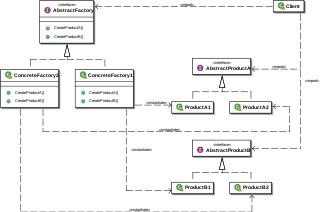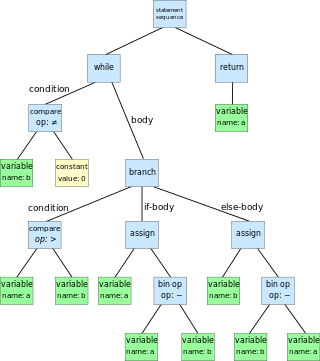Related Research Articles
In computer science, an abstract data type (ADT) is a mathematical model for data types, defined by its behavior (semantics) from the point of view of a user of the data, specifically in terms of possible values, possible operations on data of this type, and the behavior of these operations. This mathematical model contrasts with data structures, which are concrete representations of data, and are the point of view of an implementer, not a user. For example, a stack has push/pop operations that follow a Last-In-First-Out rule, and can be concretely implemented using either a list or an array. Another example is a set which stores values, without any particular order, and no repeated values. Values themselves are not retrieved from sets, rather one tests a value for membership to obtain a Boolean "in" or "not in".
Abstraction is a process wherein general rules and concepts are derived from the usage and classification of specific examples, literal signifiers, first principles, or other methods.
In object-oriented programming, a class is an extensible program-code-template for creating objects, providing initial values for state and implementations of behavior.

A Java virtual machine (JVM) is a virtual machine that enables a computer to run Java programs as well as programs written in other languages that are also compiled to Java bytecode. The JVM is detailed by a specification that formally describes what is required in a JVM implementation. Having a specification ensures interoperability of Java programs across different implementations so that program authors using the Java Development Kit (JDK) need not worry about idiosyncrasies of the underlying hardware platform.
In computer science, pseudocode is a description of the steps in an algorithm using a mix of conventions of programming languages with informal, usually self-explanatory, notation of actions and conditions. Although pseudocode shares features with regular programming languages, it is intended for human reading rather than machine control. Pseudocode typically omits details that are essential for machine implementation of the algorithm. The programming language is augmented with natural language description details, where convenient, or with compact mathematical notation. The purpose of using pseudocode is that it is easier for people to understand than conventional programming language code, and that it is an efficient and environment-independent description of the key principles of an algorithm. It is commonly used in textbooks and scientific publications to document algorithms and in planning of software and other algorithms.

The Standard Generalized Markup Language is a standard for defining generalized markup languages for documents. ISO 8879 Annex A.1 states that generalized markup is "based on two postulates":

The abstract factory pattern in software engineering is a design pattern that provides a way to create families of related objects without imposing their concrete classes, by encapsulating a group of individual factories that have a common theme without specifying their concrete classes. According to this pattern, a client software component creates a concrete implementation of the abstract factory and then uses the generic interface of the factory to create the concrete objects that are part of the family. The client does not know which concrete objects it receives from each of these internal factories, as it uses only the generic interfaces of their products. This pattern separates the details of implementation of a set of objects from their general usage and relies on object composition, as object creation is implemented in methods exposed in the factory interface.
In computer science, an instruction set architecture (ISA) is a part of the abstract model of a computer, which generally defines how software controls the CPU. A device that executes instructions described by that ISA, such as a central processing unit (CPU), is called an implementation.
In computer science, abstract interpretation is a theory of sound approximation of the semantics of computer programs, based on monotonic functions over ordered sets, especially lattices. It can be viewed as a partial execution of a computer program which gains information about its semantics without performing all the calculations.
In software engineering and computer science, abstraction is the process of generalizing concrete details, such as attributes, away from the study of objects and systems to focus attention on details of greater importance. Abstraction is a fundamental concept in computer science and software engineering, especially within the object-oriented programming paradigm. Examples of this include:
In computer science, an abstract machine is a theoretical model that allows for a detailed and precise analysis of how a computer system functions. It is similar to a mathematical function in that it receives inputs and produces outputs based on predefined rules. Abstract machines vary from literal machines in that they are expected to perform correctly and independently of hardware. Abstract machines are "machines" because they allow step-by-step execution of programmes; they are "abstract" because they ignore many aspects of actual (hardware) machines. A typical abstract machine consists of a definition in terms of input, output, and the set of allowable operations used to turn the former into the latter. They can be used for purely theoretical reasons as well as models for real-world computer systems. In the theory of computation, abstract machines are often used in thought experiments regarding computability or to analyse the complexity of algorithms. This use of abstract machines is fundamental to the field of computational complexity theory, such as finite state machines, Mealy machines, push-down automata, and Turing machines.
In computer science, the abstract syntax of data is its structure described as a data type, independent of any particular representation or encoding. This is particularly used in the representation of text in computer languages, which are generally stored in a tree structure as an abstract syntax tree. Abstract syntax, which only consists of the structure of data, is contrasted with concrete syntax, which also includes information about the representation. For example, concrete syntax includes features like parentheses or commas, which are not included in the abstract syntax, as they are implicit in the structure.

An abstract syntax tree (AST) is a data structure used in computer science to represent the structure of a program or code snippet. It is a tree representation of the abstract syntactic structure of text written in a formal language. Each node of the tree denotes a construct occurring in the text. It is sometimes called just a syntax tree.
In computer science, formal methods are mathematically rigorous techniques for the specification, development, analysis, and verification of software and hardware systems. The use of formal methods for software and hardware design is motivated by the expectation that, as in other engineering disciplines, performing appropriate mathematical analysis can contribute to the reliability and robustness of a design.
In computer science, a high-level programming language is a programming language with strong abstraction from the details of the computer. In contrast to low-level programming languages, it may use natural language elements, be easier to use, or may automate significant areas of computing systems, making the process of developing a program simpler and more understandable than when using a lower-level language. The amount of abstraction provided defines how "high-level" a programming language is.

In computer science, a stack is an abstract data type that serves as a collection of elements with two main operations:
The Web Services Business Process Execution Language (WS-BPEL), commonly known as BPEL, is an OASIS standard executable language for specifying actions within business processes with web services. Processes in BPEL export and import information by using web service interfaces exclusively.
In programming languages, an abstract type is a type in a nominative type system that cannot be instantiated directly; by contrast, a concrete typecan be instantiated directly. Instantiation of an abstract type can occur only indirectly, via a concrete subtype.

EXPRESS is a standard for generic data modeling language for product data. EXPRESS is formalized in the ISO Standard for the Exchange of Product model STEP, and standardized as ISO 10303-11.
The categorical abstract machine (CAM) is a model of computation for programs that preserves the abilities of applicative, functional, or compositional style. It is based on the techniques of applicative computing.